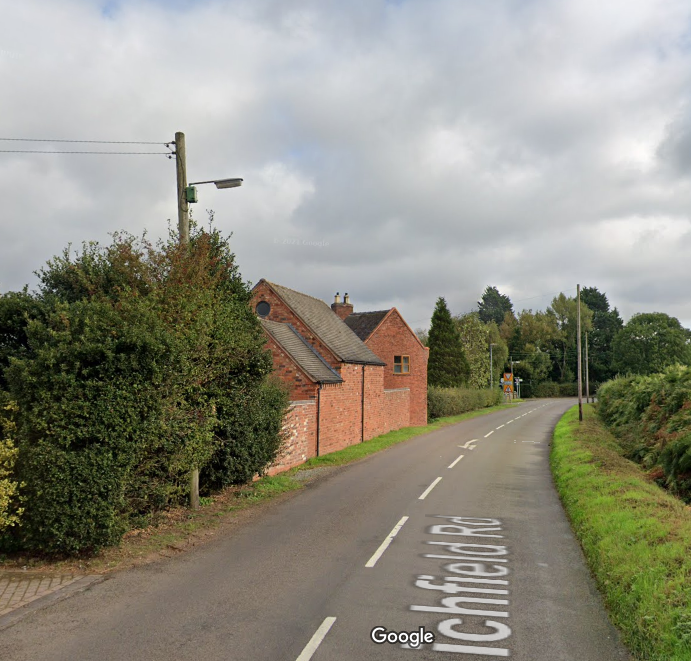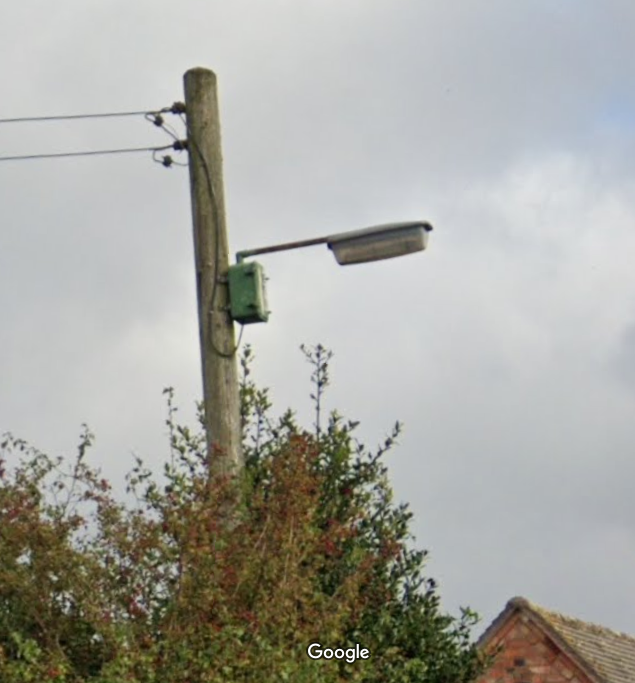
GEC Z9536
Lantern acquired in April 2023.
With thanks to AgentHalogen_87 for donating this lantern to the Collection. This lantern was removed from light number 16 on Church Street, Whittington, near Lichfield, Staffordshire. A Holophane S-Line LED lantern served as the replacement, with the existing AC Ford pole bracket and fuse box being reused to support the new lantern.
This image, taken from Google Street View, shows the lantern as it appeared when installed.

The pole bracket was fed from a dedicated overhead electricity supply, owing to the relatively rural nature of the location.

This example comprises a die-cast aluminium canopy and Perspex bowl (which has become translucent through exposure to UV light over the years). Later versions saw the aluminium changed to GRP, and the Perspex changed to polycarbonate.
A Zodion SS55-style two-part photocell detector is positioned on the canopy. Originally, the lantern would have been operated using a time switch.
Unlike the later polycarbonate bowls, the refractor panels were not moulded into the plastic with these older Perspex bowls, and had to be attached separately during manufacture using adhesive. Over time, the glue degrades, causing the panels to detach. In this example, the panels were missing completely, although as the bowl itself is now translucent, it provides a means of diffusion without the need for refractors. My older Z9532 retains its refractor panels, though curiously, its bowl fits into an aluminium support ring, whereas with this Z9536, the bowl attaches directly to the lantern - this may indicate that the Z9532 is a slightly older product.
Unfortunately, the grub screws are seized, meaning that the lantern had to be hammered off its bracket to facilitate removal. This has placed a dent in the rear of the casting, although this may be able to be pushed out with some effort.
Some flecks of green paint, applied to the pole bracket during its installation in the 1970s, are present near the spigot entry.
Easing the bowl clip open (being especially careful, as the front of the bowl is cracked) allows the lantern innards to be observed. As the lamp control gear was installed remotely, the wiring here connects to the lampholder directly, as well as to the photocell detector. If this lantern did have the control gear housed within it, the view would be similar to that seen in my Z9539.
A novel way of clamping the supply cable securely is employed here - the conductors pass beneath the connector block; effectively, trapping them in position. The use of solid green identification sleeving for the earth conductor suggests that the lantern was fitted before the end of 1977, as this was the last year that the green sleeving was permitted - the use of green and yellow sleeving becoming mandatory after this.
|
Lanterns in the Z953# range in collection |
|||||||
|
|
|
|
|
|
|
|
|
| Z9531 | Z9532 (aluminium) | Z9532 (GRP) (1) | Z9532 (GRP) (2) | Z9536 (aluminium) | Z9536 (GRP) | Z9538 | Z9539 |
ELECO HW-898 | Revo 'Hyperion B' A42.304
CLICK HERE TO MAKE A MONETARY DONATION
© 2002 - English Street Lights Online